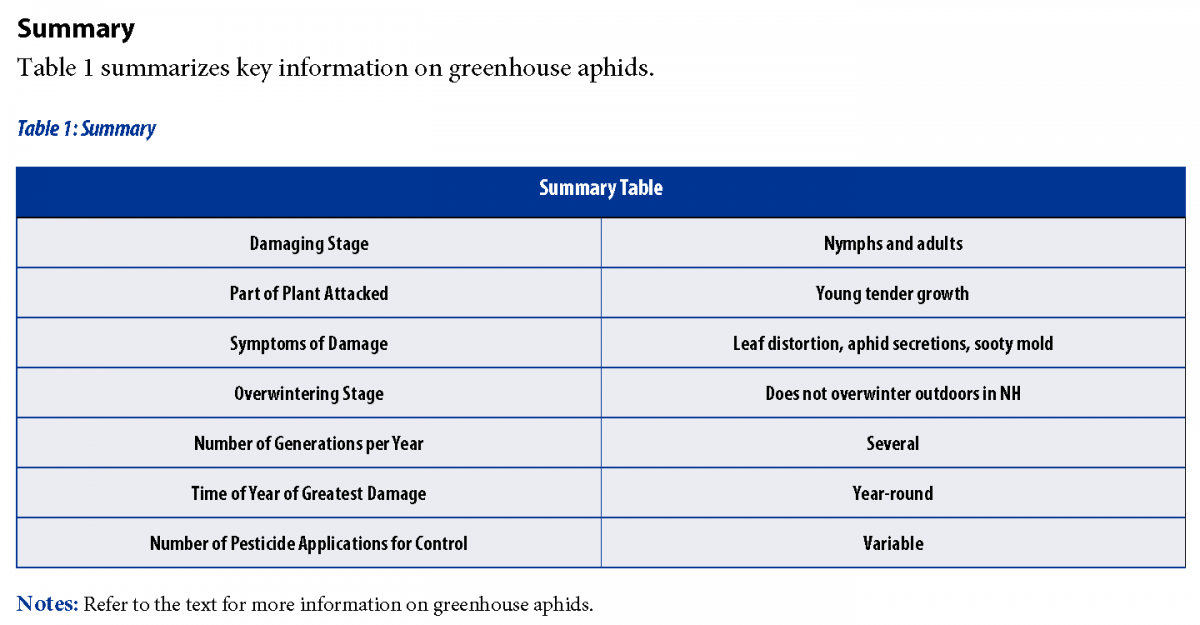Aphids (plant lice) are the most common pest in New Hampshire greenhouses. Varying in size, color, and numbers, New Hampshire growers are constantly fighting a battle with these small insect pests.
Description
Aphids are recognizable because they have (1) piercing-sucking mouthparts and (2) a pair of appendages (cornicles) near the end of their abdomen. In some species, the cornicles look like tubes. In others, they look more like buttons. Some individuals have wings, while others do not. If they have wings, there are two parallel veins along the leading edge, ending in a thickened spot. There are few veins, many of which are almost parallel (for an example, refer to the picture of a winged aphid on a yellow sticky card on page 2). When stuck to sticky cards, aphids often continue to give birth… another clue to their identity.
The most common species in greenhouses are green peach aphid (Myzus persicae), foxglove aphid (Aulacorthum solani), potato aphid (Macrosiphum euphorbiae), and melon aphid (Aphis gossypii). All are soft-bodied. Green peach aphids are usually green, but others can be red, black, brown, yellow or pink.
Growers should learn to recognize aphid mummies (aphids that have been killed by parasitic wasps). They are tan and rigid. If the wasp has emerged, there will be a large round exit hole. If the wasp has not emerged yet, there will be no hole. Seeing mummies tells you that parasites are at work. Recognizing mummies prevents you from spraying to “control” these “tan pests”.

State University, Bugwood.org.
Life Cycle and Damage
In greenhouses, all species of aphids reproduce year-round. Living young are produced by unmated females. It takes only 7-10 days for the nymph to develop into a reproductive female. This adds to the reproductive capability of the aphid. Each female is capable of producing fifty young. Therefore, aphid populations can explode very quickly.
Both nymphs and adults feed on the young tender parts of plants. They insert their mouth-parts and withdraw juices. This feeding causes distortion of leaves and bulbs. Aphids also secrete a sticky substance called "honeydew". This sweet substance attracts ants and sooty fungi. The sooty fungi can discolor the plant enough to make it undesirable for sale. Aphids are also known to be carriers of many greenhouse disease-causing organisms.

North Carolina State University, Bugwood.org.
Management
IPM Strategies
- Monitoring - Look for signs of aphid presence, including: 1. White cast skins on plant surfaces, 2. Ant activity on plants, 3. Honeydew on surfaces under plants, 4. Aphid mummies, and 5. Winged aphids on yellow sticky cards.
- Sanitation - Eliminate all weeds within and around greenhouses. Avoid planting susceptible cultivars. Inspect incoming plant material, and reject any that is infested with aphids.
- Biological Control - There are a number of commercially available natural enemies for aphids: ladybird beetles, lacewings, parasitic wasps, and predaceous midges. Apply biological controls early, before the pest population has gotten high. If you are using parasitic wasps, consider using banker plants to maximize the effectiveness of the wasps you release.
- Chemical Control - Several insecticides are available for aphid control. Make sure you select an insecticide that is registered for use on the crop you plan to use it on. Follow the label! All pesticides have the potential to damage sensitive crops. To be safe, apply to a few plants first. The key to aphid control is early and frequent applications of pesticides before populations build up.
Consult your county Agricultural Field Specialist for specific recommendations.



skins on plant surface (middle), and winged aphid on
yellow sticky card (bottom). Credit: Alan T. Eaton.

Download the resource for the complete factsheet.

